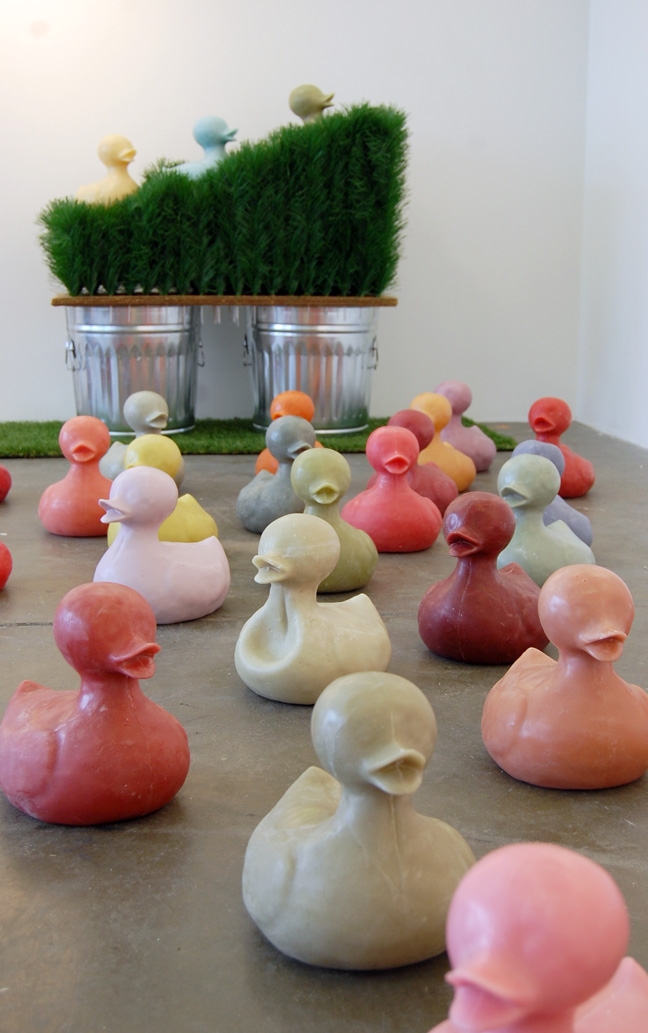An Impressionist exhibition draws high attendance; it’s a well-known movement in art history and the general public has become very familiar with it.
Though one must remember, even the now widely popular Impressionists faced a mixed reception when first emerging in the late 19th century. Their boundary-pushing work was described as “unfinished” by conservative critics of the time.
One of the more recent boundary-pushing genres is installation art, which came to prominence in the 1970s. Essentially, installation art takes into account the viewer’s entire sensory experience within a space. The items that comprise the installation remain secondary; it is the effect on the viewer’s spacial and cultural expectations that is of primary importance.
While the general public is still becoming familiar with installation art, West Michigan has enjoyed greater exposure through ArtPrize. This past year’s winner of both the critical and popular vote, Intersections by Anila Quayyum Agha, is an installation piece.
Extending the conversation for the West Michigan audience, Fire Barn Gallery of Grand Haven is presenting two consecutive exhibitions exploring this interesting genre.
“[It’s] a new direction for us,” said Chris Protas, gallery director. “In two separate solo exhibitions, artists Michael Peoples and David Heino will both use the gallery as an installation space, working on site and creating work specifically for the space. The two artists share almost nothing in common except they both work with installation.”
Michael Peoples is a Grand Haven-area artist. His work is in the practice of repetition, recently focusing on transient material. The majority of works in the exhibition are in molded wax.
“Subject and color is where I find my connection,” Peoples said. “When choosing an object to reproduce, I search for an underlying personal symbolism. Something I relate with but do not have a complete understanding of why. I see what I do as conceptual, the transmutation of an idea into form.”
|
Michael Peoples: WUNDERKAMMER (German for ‘Cabinet of Curiosities’)
|
David Heino currently resides in Milwaukee. He questions the notion of applying labels or names to artists or their work, and that words should not have importance to an audience’s experience of the visual arts.
“Last year, I participated in the Maker Faire we had here in Milwaukee. I showed what I had of Rainland,” said Heino, who is planning to have two versions of this particular work in Grand Haven. “People liked it. No one went on and on about Art. Kids stuck their hands in it. It was quite wonderful.”
Heino bends the common definition of installation art. He acknowledges that he is very much aware of the gallery environment at Fire Barn, and would like to see a meaningful whole of work and space, but won’t be tied to notions of a unitary world akin to a theater stage.
“My show will be a collection of paintings and other things,” Heino said. “It just so happens that painting has been my primary means of expression for most of my life, but I do other things as well.”
OTHER ART EVENTS
Power Objects: The Future Has a Primitive Heart
Urban Institute for Contemporary Arts
2 W. Fulton, Grand Rapids
March 14-May 15, 2015
uica.org, (616) 454-7000
From the first cave paintings and fertility statues to “Post-Internet” art, the objective over thousands of years is similar. Art objects are designed to express and connect to the sublime, the transcendent, the powerful forces and instincts that are part of human existence. This selection of works from the collection of Josh Rogers and Lesley Weisenbacher explores the ways in which today’s artists are interpreting and making new power objects.
Redefining the Multiple
Kalamazoo Institute of Arts
314 S. Park St., Kalamazoo
Through April 26, 2015
kiarts.org, (269) 349-7775
This exhibition features the work of Japanese artists with foundations and formal training in printmaking. Although each of the participating artists’ personal work has transitioned over the years—some is now more associated with other media—printmaking and the production of multiples remains at the core of their creative processes. Curated by Hideki Kimura, Kyoto City University of Arts, Kyoto, Japan; and Sam Yates, Director, Ewing Gallery of Art and Architecture, University of Tennessee, Knoxville.
Frozen in Time: Photography by Tony Reidsma
Holland Area Arts Council
150 E. 8th St., Holland
March 5-April 18, 2015
hollandarts.org, (616) 396-3278
Frozen in Timewas a project Reidsma began during the winter of 2014. That winter brought record-breaking cold temperatures, which led to record ice coverage on Lake Michigan. Reidsma set out to document this unique occurrence. The original purpose of the project evolved beyond the 2014 weather to include recording the effects of the drastically changing water levels of Lake Michigan.





